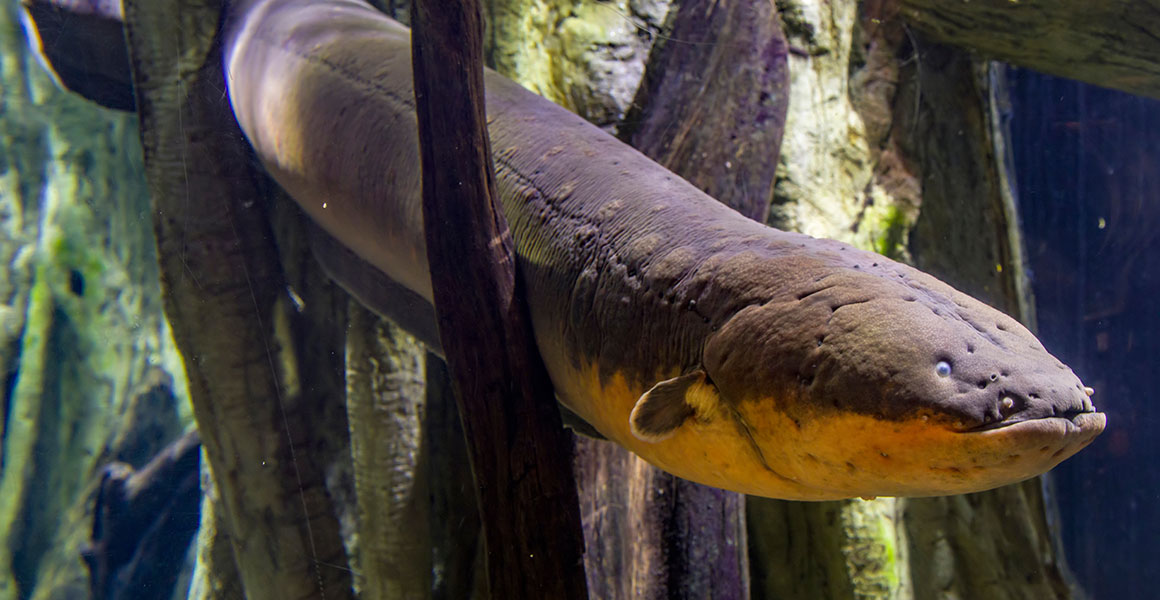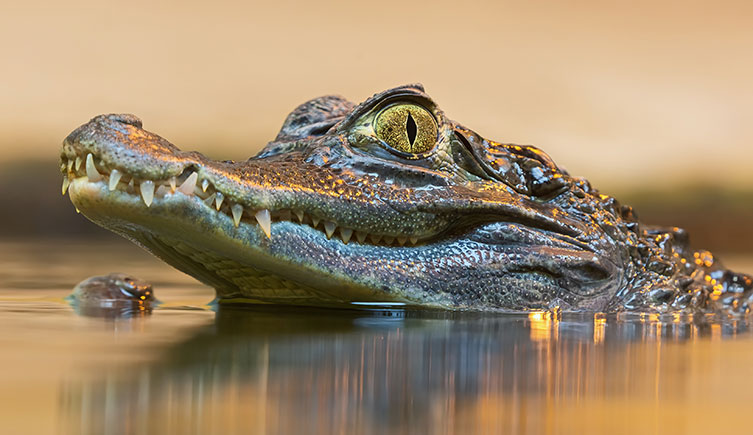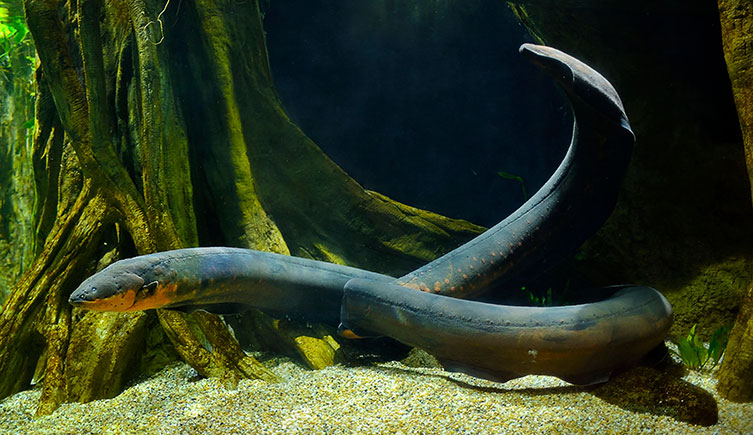Electric eels are remarkable, snake-like fish with the power to deliver electric shocks to defend themselves, hunt, navigate and even communicate with one another.
But how does their amazing ability work?

Electric eels can deliver a powerful electric shock. They also use weaker electric impulses to navigate, hunt and communicate. © Danny Ye/ Shutterstock
Electric eels are remarkable, snake-like fish with the power to deliver electric shocks to defend themselves, hunt, navigate and even communicate with one another.
But how does their amazing ability work?
Electric eels are long, cylindrical fish with flattened heads. Though they’re commonly called eels, they’re not Anguilliformes, which are ‘true’ eels. Instead, electric eels belong to the order Gymnotiformes, also known as knifefishes, and are more closely related to catfishes and carp.
We’ve known about electric eels for more than 250 years and, for a long time, it was thought that there was only one species. But in 2019, scientists split the genus into three distinct species – the original species Electrophorus electricus and the newly described species Electrophorus varii and Electrophorus voltai.
Electric eels can grow to more than 2.5 metres in length and weigh up to 22 kilograms.

Electric eels have tiny pectoral fins behind their jaws and an anal fin that runs the length of their underside. Together these fins allow the eel to swim both forward and backwards, as well as hover in the water. © Bigone/ Shutterstock
“Electric eels are like living batteries,” explains Dr Rupert Collins, our Senior Curator of Fishes. “They have stacks of modified muscle cells called electrocytes that have both a positive and a negative side. When the cells are triggered, it discharges an electrical impulse into the surrounding water.”
It was by studying the electric eel that Italian scientist Alessandro Volta was able to invent the first battery in 1800.
Electric eels have three special organs that help them create electricity. These are known as the main organ, the Hunter’s organ and the Sach’s organ. These organs take up about 80% of the eel’s body and allow them to produce electric impulses of different strengths, which perform different functions.
The main organ and part of the Hunter’s organ produce strong electric shocks that can ward off predators or stun prey. The Sach’s organ and the other half of the Hunter’s organ produce weak electric impulses. Electric eels use these to navigate, seek out prey and signal one another for courtship during the breeding season.
Electrophorus varii can produce the most powerful electrical shocks. They can generate up to 860 volts of electricity – nearly four times the voltage of a standard UK plug socket.
Electric eels are found in the freshwaters of the Amazon and Orinoco rivers of northern South America. They typically seek outslow-moving, murky waters such as pools, swamps and oxbow lakes, but can also be found in streams and rocky environments.

Electric eels have very poor eyesight and rely on their electrolocation abilities to navigate the murky backwaters of the Amazon and Orinoco rivers. © Daniel Pask/ Shutterstock
While most fishes breathe by passing water over their gills and absorbing the oxygen in it, electric eels breath air. They have to surface to breathe about every 10 minutes. This allows them to live in waters that contain very little oxygen.
During the dry season, bodies of water can become isolated from one another. The water levels of the eels’ muddy ponds and pools can get extremely low, leaving the fish more vulnerable to predators.
This is when their electric shock abilities are particularly valuable, helping to deter predators such as jaguars and caiman.

The caiman, a member of the alligator family, is one of the few species that attempts to eat electric eels. © Henner Damke/ Shutterstock
Water is a good conductor of electricity. This means that if a predator is shocked while fully submerged under the water, it will feel a less powerful shock than it would if it was out of the water. Electric eels are able to leap partially out of the water and press themself against a predator.
“Electric eels can leap out of the water and attach the most positively charged part of their body – their chin – to the predator. With their negative pole still in the water, this creates a powerful closed electrical circuit. This prevents electrical charge dispersing out into the water and instead all the electricity gets dumped into whatever is trying to catch it,” explains Rupert.
The result is a highly powerful jolt that’s sure to put off predators.
As well as hunting alone, there’s some evidence that electric eels engage in social predation. They work together to herd prey into a small space and issue coordinated electric shocks to stun their food items.

Electric eels grow up to more than 2.5 metres in length. They can partially leap out of the water to shock predators. © tristan tan/ Shutterstock
In theory, if threatened, an electric eel could leap partway out of the water and deliver multiple electric shocks powerful enough to cause an adult person to have a heart attack or stop breathing. The shock could also result in a person drowning, even in shallow water.
However, electric eels aren’t actually particularly aggressive and won’t attack unless they feel cornered. It’s very rare for people to be killed by electric eels.
“Electrical-sensing abilities are very common in fishes,’ explains Rupert. ‘Even a tiny worm will release an electrical signal into water that could be picked up by a predator like a fish using specialised sensory organs called electroreceptors.”
“For most fish species, this is passive. It’s a sense a bit like smell that helps them identify and locate prey items. But around 1–2% of fishes have active electrolocation where they emit electricity themselves in murky water or at night to be able to navigate.”
Among these species are many Osteoglossiformes, which include elephantnose fishes and the African knifefish. This group has the same ability to produce weak electrolocation but, evolved it in a different way to the electric eel. This is an example of convergent evolution.
Far fewer fishes can deliver strong electric shocks. In addition to electric eels, this includes several species of catfishes, stargazers and rays.
The electric eel’s relative the bluntnose knifefish has evolved a similar form of electrolocation to the electric eel. In fact, it may have developed this ability in order to mimic the electric eel. By putting out a similar electrical signal into the water, the bluntnose knifefish may be trying to convince predators there’s an electric eel nearby and that they should keep their distance. This is known as Batesian mimicry.

The electric whitemargin stargazer belongs to a different order of fish than the electric eel but shares its ability to stun prey before devouring them whole. © Laura Dts/ Shutterstock
Electric eels typically reproduce in the dry season or at the beginning of the wet season.
Male electric eels create a bubble nest into which the female releases eggs to be fertilised. Over the course of the nesting season, a female may release up to 1,200 eggs.
An electric eels’ diet is primarily made up of fish, but they will also eat crabs, insects, amphibians and mammals.
The electric eel inspired the first battery, but could these animals be a source of renewable energy?
“In a word, no!” says Rupert. “It wouldn’t be ethical or efficient.”
“Firstly, they don’t discharge high-power electricity continuously. They only use it intermittently and it takes them a long time to recharge. Secondly, making eels live in some kind of eel power plant would be a horrible existence for them, and you would have to feed them and heat them so it would not be ‘free’ energy.”
However, there are other ways electric eels could inspire us.
“We might be able to take electric eel tissue and culture it in a lab to grow biobatteries for storing energy,” suggests Rupert.
One team of researchers has drawn upon the electric eel to create a powerful, flexible battery that may one day be able to power pacemakers and other implantable electric devices. This is known as biomimicry – where the natural world inspires solutions to human challenges.
More than two centuries since their discovery, there’s still so much to learn about and from electric eels.

Just how weird can the natural world be?
Don't miss a thing
Receive email updates about our news, science, exhibitions, events, products, services and fundraising activities. We may occasionally include third-party content from our corporate partners and other museums. We will not share your personal details with these third parties. You must be over the age of 13. Privacy notice.
Follow us on social media